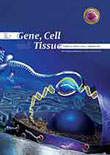فهرست مطالب

Gene, Cell and Tissue
Volume:1 Issue: 3, Oct 2014
- تاریخ انتشار: 1393/10/08
- تعداد عناوین: 8
-
-
Page 2BackgroundFormaldehyde (F) is a chemical component that has an extensive usage on fixation of tissues and produces different types of reactive oxygen species (ROS) in our body. Studies have shown that long exposure to F damages the eyes, nose and throat; in addition it has adverse effects on body organs such as the urinary system. Vitamins can reduce free ROS..ObjectivesThe aim of this study was evaluating the protective effect of vitamin E on the kidney damaged by formaldehyde..Materials And MethodsMale adult wistar rats were divided into three groups. Group A (control): rats received vehicle (normal saline) for two weeks. Group E1 (formaldehyde): rats received formaldehyde (10 mg/kg) for two weeks. Group E2 (formaldehyde + vitamin E): rats received formaldehyde (10 mg/kg) and vitamin E (30 mg/kg) for two weeks. After two weeks, all rats were killed, and the kidneys were dissected and processed for routine histological staining..ResultsComparison of the control and formaldehyde groups with the vitamin E group revealed that there were significant differences in lumen size and nuclear color of proximal tubules in rats treated by vitamin E (P < 0.05). Cell degeneration, lumen size, number and size of nucleus of distal tubules were statistically different among the three groups. In the vitamin E treated group observed histological changes were improved compared to the formaldehyde group..ConclusionsAccording to the results of this study, vitamin E probably improves the harmful effects of formaldehyde on rat kidney tissue.Keywords: Formaldehyde_kidney_Vitamin E rat_histology_injuries
-
Page 3Background
Tuberculosis (TB) is an acute or chronic bacterial infection caused by Mycobacterium tuberculosis. It primarily affects the lungs, but may spread to other organs (extra-pulmonary TB)..
ObjectivesStudies have shown that genetic predisposition can decrease the persistence and growth of M. tuberculosis. The current study highlights the effect of CTLA-4 (+49A/G) gene polymorphism on the risk of TB..Patients and
MethodsThis case-controlled study used tetra-primer amplification refractory mutation system-polymerase chain reaction (ARMS-PCR) to analyze theCTLA-4 (+49A/G) gene polymorphism in 100 patients with TB and 91 healthy individuals..
ResultsData analysis indicated that the frequencies of AA, AG and GG genotypes were 42%, 38%, and 20% in patients with TB and 43%, 47%, 1% in the control subjects, respectively. The GG genotype of CTLA-4 (+49A/G) showed a significantly increased risk of disease (OR = 20.48; 2.63-159.60).
ConclusionsThe results revealed a significant relationship between the GG genotype of CTLA-4 and the increased risk of TB.
Keywords: Tuberculosis, Mycobacterium, CTLA, 4 -
Page 5BackgroundVariation in drug resistance and susceptibility to various diseases may be related to difference in allele frequencies of the variants at the population level..ObjectivesThe present study aimed to investigate the allele frequencies of five short tandem repeats (STR) loci in two different chromosomes of candidates from Tehran Lipid and Glucose Study..Materials And MethodsFor this study, a representative sample of 563 individuals (130 affected by metabolic syndrome) from Tehran, including four different ethnic groups of Iran, was selected. Five STRs including D12S1632, D12S329, D12S96, D16S3096 and D16S2624 were analyzed using the fragment analysis method. Allele frequency, polymorphism information content (PIC) values, observed and expected heterozygosity, discrimination power, matching probability, power of discrimination, power of exclusion and paternity index were calculated for the whole sample..ResultsThere was no significant deviation in allelic frequencies from Hardy-Weinberg equilibrium for all the studied markers except for D12S1632 and D12S329. The long alleles in D12S329 were significantly more frequent in patients with metabolic syndrome (P < 0.05)..ConclusionsThis study revealed allele frequency of some STRs on chromosome 12 and 16 for the first time in Iran, and indicated differences between subjects with metabolic syndrome and subjects in the control group..Keywords: Chromosome 12, Chromosome 16, Allele Frequency, Ethnic Groups, Iran
-
Page 6BackgroundPhysical activity and alteration of temperature as a source of stress may have adverse effects on male reproduction..ObjectivesThe aim of this study was to investigate the effect of chronic swimming and standing in cold, warm and lukewarm water on mouse spermatogenesis..Materials And MethodsForty-nine male mice (N = 49) were randomly divided into seven groups: C, control; SwC, swimming in cold water (10°C); StC, standing in cold water (10°C); SwL, swimming in lukewarm water (23°C); StL, standing in lukewarm water (23°C); SwW, swimming in warm water (36°C); StW, standing in warm water (36°C). Animals in swimming groups were submitted to daily forced swimming for five minutes for five consecutive days/week during five weeks. However groups StC, StL and StW were only standing on a raised platform inside the water pool, without swimming, for the same time and duration. Evaluations on day 36 were made using enzyme linked immunosorbent assay (ELISA), Johnsen score and immunohistochemistry for assay of serum testosterone, luteinizing hormone (LH) levels, quality of spermatogenesis and detection of apoptosis, respectively..ResultsSerum LH and testosterone levels as well as Johnsen score were significantly reduced in all groups except for the group standing in lukewarm water (P < 0.05). Apoptosis was increased only in the swimming or standing in warm water groups (P < 0.05)..ConclusionsThis study indicates that forced swimming and standing in all water temperatures has adverse effects on male fertility parameters, the only exception is standing in lukewarm water, which seems to be safe for male fertility parameters..Keywords: Swimming, Temperature, Apoptosis, Spermatogenesis

